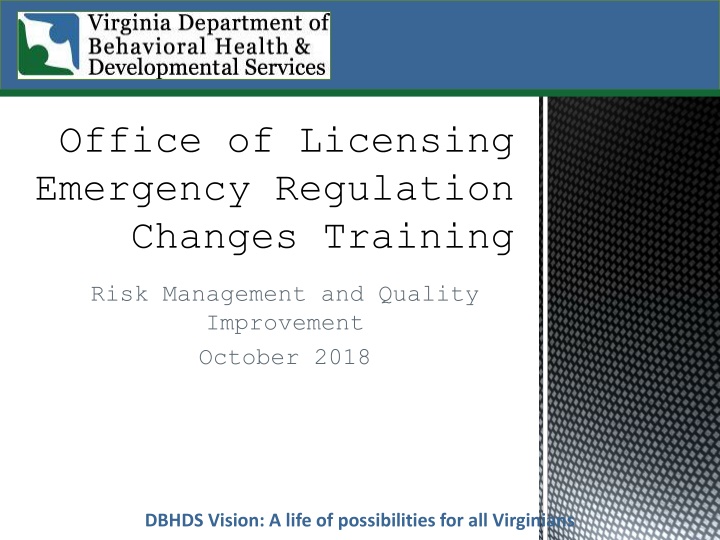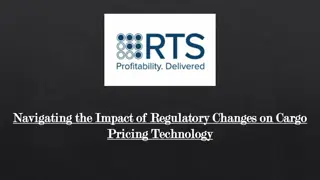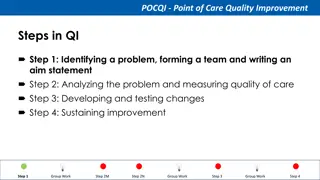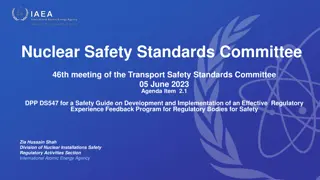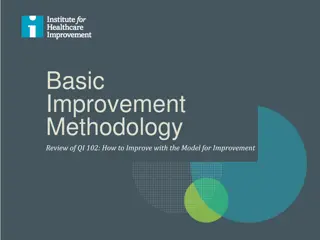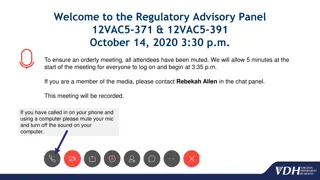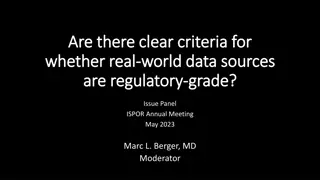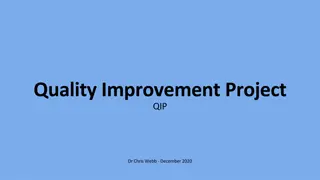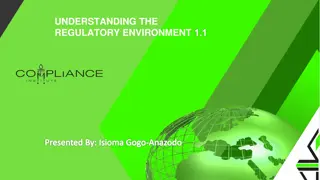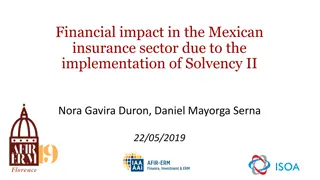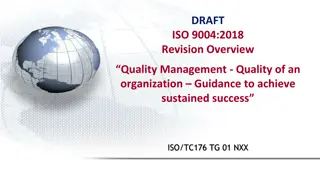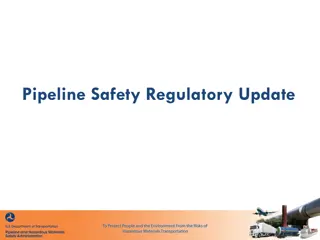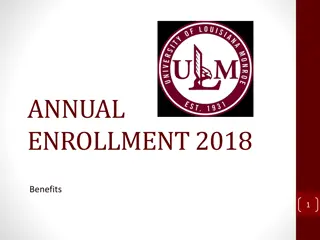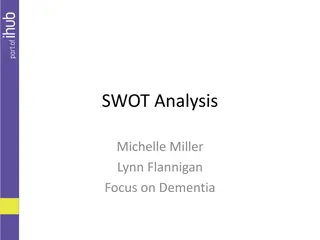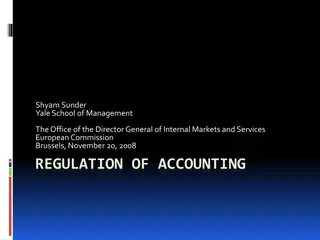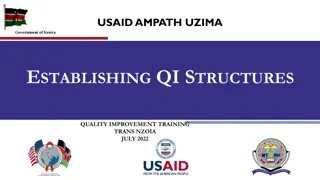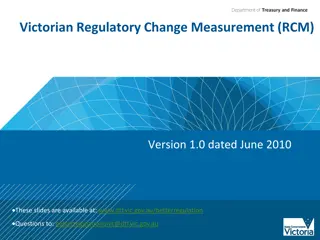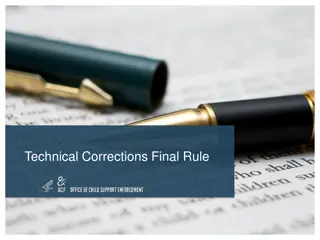Regulatory Changes and Quality Improvement in October 2018
The content discusses regulatory changes related to risk and quality improvement in October 2018, focusing on serious incidents, reporting requirements, risk management, and monitoring service quality. Providers are mandated to review, analyze trends, identify systemic issues, recommend remediation, and document steps to mitigate future incidents. Reporting protocols for Level I, II, and III serious incidents are outlined, emphasizing timely reporting and detailed information. The importance of root cause analysis for continuous quality improvement is also highlighted.
Download Presentation

Please find below an Image/Link to download the presentation.
The content on the website is provided AS IS for your information and personal use only. It may not be sold, licensed, or shared on other websites without obtaining consent from the author.If you encounter any issues during the download, it is possible that the publisher has removed the file from their server.
You are allowed to download the files provided on this website for personal or commercial use, subject to the condition that they are used lawfully. All files are the property of their respective owners.
The content on the website is provided AS IS for your information and personal use only. It may not be sold, licensed, or shared on other websites without obtaining consent from the author.
E N D
Presentation Transcript
Office of Licensing Emergency Regulation Changes Training Risk Management and Quality Improvement October 2018 DBHDS Vision: A life of possibilities for all Virginians
Regulatory Changes Related to Risk and Quality 12VAC35-105-20: Definition of Serious Incident (separate power point) 12 VAC 35-105-160: Required reporting 12VAC35-105-520: Risk Management 12VAC35-105-620: Monitoring and Evaluating Service Quality Slide 2
12VAC35-105-160 Reviews by the Department; Requests for Information; required reporting Provider must review all Level I serious incidents, at least once per quarter. The provider shall collect, maintain, and review at least quarterly all Level I serious incidents as part of the quality improvement program in accordance with 12VAC35-105-620 to include an analysis of trends, potential systemic issues or causes, indicated remediation, documentation of steps taken to mitigate the potential for future incidents. Slide 3
12 VAC 35-105-160 Level I Serious Incidents What Specialists will look for: Analysis of trends The provider has clear method for trending data, i.e., looks for trends by type of incident, by individual, environment in which incident occurred. Potential systemic issues or causes The provider compares trend information with its own policies, procedures, or protocols to see if they are still appropriate. Indicated remediation The provider makes recommendations to prevent a reoccurrence. Documentation of steps to mitigate potential for future incidents Provider documents actions taken to reduce or manage likelihood or severity of adverse outcome. Slide 4
12 VAC 35-105-160 Level II & Level III Serious Incidents Level II and Level III serious incidents shall be reported using the department's web-based reporting application & by telephone to anyone designated by the individual to receive such notice & to individual's authorized representative within 24 hours of discovery. Reported information shall include the information specified by the department as required in its web-based reporting application, but at least the following: the date, place, & circumstances of the serious incident. For serious injuries and deaths, the reported information shall also include the nature of the individual's injuries or circumstances of the death & any treatment received. For all other Level II & Level III serious incidents, the reported information shall also include the consequences or risk of harm that resulted from the serious incident. Slide 5
Root Cause Analysis 12VAC35-105-160E
12VAC35-105-20 - Root Cause Analysis Definition DBHDS Regulation 12VAC35-105-20 defines a root cause analysis (RCA) as a method of problem solving designed to identify the underlying causes of a problem. The focus of a root cause analysis is on systems, processes and outcomes that require change to reduce the risk of harm. Slide 7
12VAC35-105-160 Root Cause Analysis Requirements Root cause analysis shall be conducted by the provider within 30 days of discovery of Level II and Level III serious incidents. Shall include at least the following information: a detailed description of what happened; an analysis of why it happened, including identification of all identifiable underlying causes of the incident that were under the control of the provider; identified solutions to mitigate its reoccurrence. Slide 8
12VAC35-105-160 - Root Cause Analysis Continued What Licensing Specialists will Look for During Inspections? Proof that: Provider has a clearly documented process for when and how RCA will be conducted; Staff have been trained on how to complete a RCA; There is a completed RCA for each Level II and Level III serious incident; RCA clearly contains all required components; Changes are made as a result of RCA, as appropriate such as revised protocols or policies; If changes are not made, reasons why are clearly documented; Changes are clearly communicated to all staff at all levels; and Changes are monitored to ensure they are effective. Slide 9
12VAC35-105-160 - Root Cause Analysis Continued Is it ever ok not to complete a RCA for Level II or III serious incidents? No, a provider must document a detailed description of the event to the best of their knowledge, understanding if the incident did not occur within their services or on their property they may have limited knowledge of the incident . Provider should conduct a an analysis of why the event occurred and note if a determination is made that potential underlying causes of the incident were not under their control of the provider; It is important to note that some level of analysis is required to determine whether or not the incident was under the control of the provider. Slide 10
12VAC35-105-160 - Root Cause Analysis Example #1 Example 1:An individual passes away from cancer while at home with their family. This death was expected and there are not additional complicating circumstances. Provider Action: All providers must submit an incident report for a level III serious incident but none of the providers need to complete a RCA. The reason for not completing a RCA must be clearly documented in individual s file. Slide 11
12VAC35-105-160 - Root Cause Analysis Example #2 Example 2: An individual who is receiving case management services and lives in a sponsored home setting is running down their driveway at home and falls and hits their head, is taken to the doctor and is diagnosed with a concussion. Provider Action: Only sponsored home provider submits an incident report. First response may be that a RCA is not necessary. However there are likely important factors to consider such as has the individual had a change in medication; was the ground slippery, have other people slipped in that same area, etc. The provider must complete a RCA. Slide 12
12VAC35-105-160 - Root Cause Analysis Example #3 Example 3: An individual living in a supervised living situation attempts suicide while at their licensed home and is hospitalized as a result Provider Action: All providers submit an incident report for a level III incident Residential Provider: Completes RCA Case Manager: The CSB should complete a RCA. While at first it may seem that the identifiable underlying causes of the incident were not under the control of the CM, the CSB team responsible for reviewing incidents should still attempt to determine if there are any systems, processes or outcomes that require a change to reduce the risk of harm in the future or any potential solutions to mitigate its reoccurrence and take action accordingly. Slide 13
Risk Management 12VAC35-105-520 Slide 14
12VAC35-105-520 Risk Management A. The provider shall designate a person responsible for the risk management function who has training and expertise in conducting investigations, root cause analysis, and data analysis. OL Specialists will look for evidence that: The provider has a designated person who is assigned to complete risk management responsibilities; The designated person has received training in investigations, RCA and data analysis; and The designated person has expertise in conducting investigations, RCA and data analysis. Slide 15
12VAC35-105-520 Risk Management Provider Requirements B. The provider shall implement a written plan to identify, monitor, reduce, and minimize harms and risk of harm, including personal injury, infectious disease, property damage or loss, and other sources of potential liability. Slide 16
12VAC35-105-520 Risk Management Provider Requirements Continued C. The provider shall conduct systemic risk assessment reviews at least annually to identify and respond to practices, situations, and policies that could result in the risk of harm to individuals receiving services. The risk assessment review shall address (i) the environment of care; (ii) clinical assessment or reassessment processes; (iii) staff competence & adequacy of staffing; (iv) use of high risk procedures, including seclusion and restraint; & (v) a review of SI. This process shall incorporate uniform risk triggers and thresholds as defined by the department. Slide 17
12VAC35-105-520 Risk Management Provider Requirements D. The provider shall conduct and document that a safety inspection has been performed at least annually of each service location owned, rented, or leased by the provider. Recommendations for safety improvement shall be documented and implemented by the provider. E. The provider shall document serious injuries to employees, contractors, students, volunteers, and visitors that occur during the provision of a service or on the provider's property. Documentation shall be kept on file for three years. The provider shall evaluate serious injuries at least annually. Recommendations for improvement shall be documented and implemented by the provider. Slide 18
Monitoring & Evaluating Quality Services 12VAC35-105-620 Slide 19
12VAC35-105-620 - Monitoring & Evaluating Quality Services The provider shall develop and implement a quality improvement program sufficient to identify, and evaluate clinical and service quality and effectiveness on a systematic and ongoing basis. Slide 20
12VAC35-105-620 Quality Improvement Program The Quality Improvement Program shall: (i) Include a QI plan that is reviewed & updated at least annually; (ii) Establish measurable goals and objectives; (iii) Include & report on statewide performance measures, if applicable, as required by DBHDS; (iv) Utilize standard QI tools, including root cause analysis; (v) Implement a process to regularly evaluate progress toward meeting established goals & objectives; (vi) Incorporate any corrective action plans pursuant to 12VAC35-105-170. The provider shall also implement improvements, when indicated. Slide 21
Quality Improvement Program (i) Quality Improvement Plan The program shall: (i) Include a QI plan that is reviewed & updated at least annually DBHDS regulation 12VAC35-105-20 defines a quality improvement plan as a detailed work plan developed by a provider that defines steps the provider will take to review the quality of services it provides and to manage initiatives to improve quality. It consists of systematic and continuous actions that lead to measurable improvement in the services, supports, and health status of the individuals receiving services. Slide 22
Quality Improvement Program (i) Quality Improvement Plan Continued Why is a quality improvement plan important? The quality improvement plan is the written document that clearly describes the providers quality improvement approach Good quality improvement plans hold people/providers accountable Quality improvement plans create an expectation to reach specific milestones within a given timeframe Seeks input from those receiving services Clearly communicates to those receiving services what is important to the provider Slide 23
Quality Improvement Program (i) Quality Improvement Plan Continued No specific template required for creating a quality improvement plan but it must be reviewed and updated at least annually (every 365 days). Plan should be updated more frequently if needed. Events which may prompt the provider to update their quality improvement plan include: the occurrence of relevant events such as the issuance of a Corrective Action Plan (CAP). changes in systems or programs Annual review should include an evaluation of the effectiveness of the quality improvement program and a determination of whether the provider seeks to change how quality improvement work is accomplished. Slide 24
Quality Improvement Program (ii) Establish Measurable Goals and Objectives The program shall (ii) establish measurable goals and objectives The Quality improvement program should include opportunities for improvement shown as measurable goals and objectives. No DBHDS requirement for specific number of goals and objectives. May use data already collected Goal to increase safety during emergencies (objective related to fire drills) Goals related to maintaining a well trained workforce (i.e., objective of low turnover; Compliance with the HCBS settings requirements, if applicable, to the licensed setting. Slide 25
Quality Improvement Program (ii) Establish Measurable Goals and Objectives Cont. When establishing goals and objectives, a provider may consider the following: Is it is clear what is being measured and why? What collection methods and sources of data are available? What is the frequency of measurement? How will provider know if plan is successful? What is the timeframe for achieving the goal or objective? Who will be collecting and analyzing data? Who will be ensuring that goals or objectives are met? Slide 26
Quality Improvement Program (iii) Include and Report on Statewide Performance Measures The program shall (iii) include and report on statewide performance measures, if applicable, as required by DBHDS As DBHDS requires statewide performance measures, it will provide information regarding reporting to licensed providers. Slide 27
Quality Improvement Program (iv) Utilize standard QI tools, Including Root Cause Analysis The program shall . (iv) utilize standard quality improvement tools, including root cause analysis The regulations do require providers to use standardized tools for measuring quality improvement. However, the regulations do not require providers to use specific quality improvement tools. Examples of standardized tools for measuring QI: Plan, do, check, act (PDCA). Root cause analysis (RCA). 5 Whys Failure Modes Effect Analysis Cause and effects diagrams Fishbone diagrams Slide 28
Quality Improvement Program (v) Implement a Process to Regularly Evaluate Progress The program shall . (v) implement a process to regularly evaluate progress toward meeting established goals and objectives The provider should identify, review, monitor the quality improvement program and make recommendations regarding progress towards goals and objectives for the QI Plan and QI activities. The provider should also learn from unsuccessful and successful endeavors. Slide 29
Quality Improvement Program (vi) Incorporate any corrective action plans pursuant to 12VAC35-105-170 The program shall . (vi) incorporate any corrective action plans pursuant to 12VAC35-105-170 The provider should identify any systematic actions that may be taken to address deficiencies identified by citations or CAPs and incorporate these into their quality improvement plan. Slide 30
Resources Tools and Templates for Risk Management and Quality Improvement Further information and resources related to risk management, quality improvement, and root cause analysis are located at: http://www.dbhds.virginia.gov/quality- management/facility-quality-and-risk-management Slide 31
